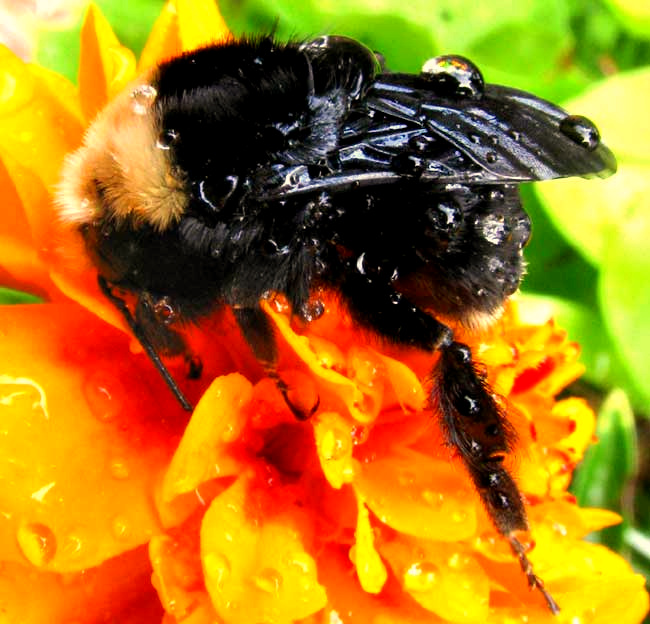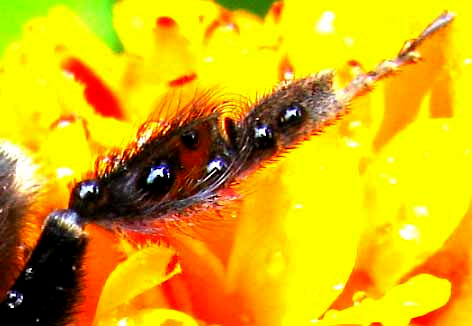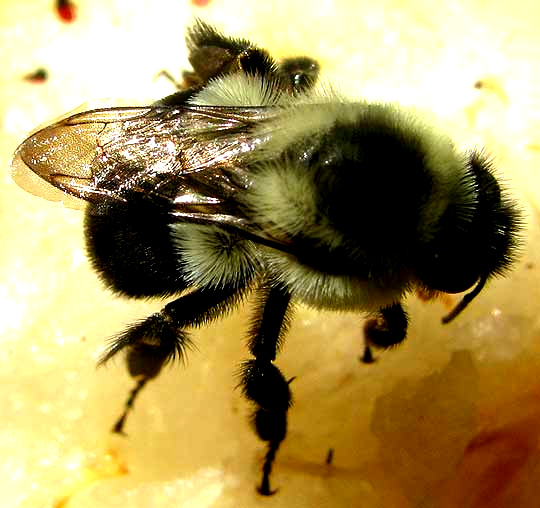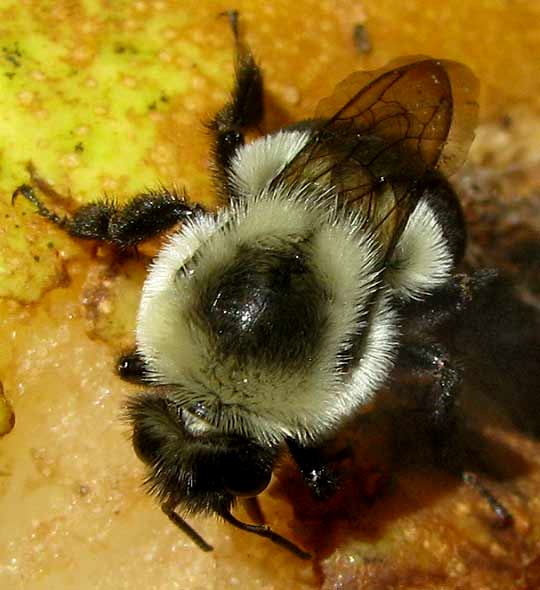Excerpts from Jim Conrad's
Naturalist Newsletter

from the October 4, 2009 Newsletter, issued from the Siskiyou Mountains west of Grants Pass, Oregon:
A COLD, SODDEN BUMBLEBEE
This week the hot dry season has suddenly snapped into the chilly rainy season. This weekend there was spotty frost in the area, and rain, with the snowfall line dropping ever lower in elevation. Tuesday with a temperature of 47°F (8.3°C), after a bone-chilling drizzle, I was wheel-barrowing leaf mulch into Anita's flower garden when I spotted the pitiful sight shown above.
A bumblebee lay atop a marigold flower sodden from the rain, not moving a hair even when I nudged her (worker bumblebees are female). In the picture, just inside the leg at the far left, you can even see the proboscis, her straw-like mouthpiece, extended downward into empty space, as if frozen in place by a sudden temperature drop.
I've often found bumblebees on flowers like this after a cold night. Are they dead, or just spending the night, planning to fly off when it warms up? I watched the bee throughout the morning and she didn't move. Later that afternoon after a few rays of sunshine had broken through -- she was gone!
I read that bumblebees sometimes forage into the night as well as during bad weather, their dense, hairy coats insulating them from the elements. However, sometimes they overdo it. If their body temperature drops much below 86°F (30°C) they can't stay airborne. Of course they can maintain that warm body temperature in colder air, but they must remain very active to do so. If a bee finds itself trapped away from its colony with night coming on or it turns cold fast, they may spend the night on a flower head, their metabolic rate much reduced, leaving only when it warms up the next day.
from the October 4, 2009 Newsletter, issued from the Siskiyou Mountains west of Grants Pass, Oregon:
A BUMBLEBEE'S CORBICULA
Over 250 species of bumblebee are known so identifying them to species level can be a challenge. In fact, often other kinds of bees are confused with bumblebees, especially carpenter bees. In southern Mississippi I see many more carpenter bees than bumblebees. Carpenter bees generally have hairless, shiny abdomens (the big rear-end segments) while bumblebee abdomens are hairy. You can see that our marigold bumblebee is hairy.
Also, bumblebees are best distinguished from other kinds of large, fuzzy bees by the form of the female's hind leg, which is modified to form a corbicula. The corbicula, sometimes called the pollen basket, is a shiny, hairless, concave surface surrounded by a fringe of hairs. It's used to transport pollen. In similar bees the hind leg lacks the concavity and pollen grains are merely wedged into the hairs for transport.
Drastically enlarging and overexposing the photo of our bee's hind leg with PhotoShop, I got what's shown below:

Can you see the concave corbicula? It has water droplets inside its scoop part. Notice how longer hairs at the corbicula's base curve inward, sort of extending the scoop's sides so that the corbicula can hold more pollen.
A picture-key to some of North America's bumblebees is found at http://www.bumblebee.org/NorthAmerica.htm.
from the July 29, 2012 Newsletter issued from the woods of the Loess Hill Region a few miles east of Natchez, Mississippi, USA
BUMBLE BEES ON PEARS
Though nowadays I eat between six and ten pears daily -- mostly sliced into cornbread batter and baked over a campfire to produce something like a sweet, juicy pear cobbler -- several pears do escape me and end up rotting in grass below the trees. During the night deer and other critters come and chomp on them, and all day long bumble bees cluster on the pears' exposed interiors, apparently drinking sweet pear juice as shown below:

Another view of the bee is shown below:

Wing venation is shown below:

This bumble bee doesn't look like the ones usually illustrated for eastern North America. There are different species of them and what we have here in southern Mississippi isn't the bumble bee one I remembering growing up in rural western Kentucky.